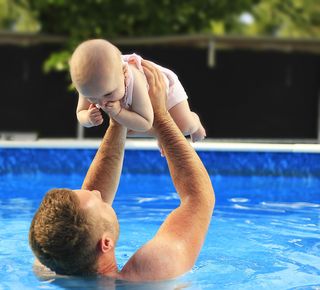Divorce
Does Divorce Damage Infants and Toddlers?
How to minimize the impact of divorce on infants and toddlers.
Posted December 16, 2016 Reviewed by Ekua Hagan

Parents going through a divorce frequently forget to differentiate between their own needs and those of their children.
Erik Erikson explained that infants experience their world as trusting or untrusting (“trust versus mistrust”) based on the quality and consistency of their parental care. Regardless of how infants resolve this first-stage challenge (whether or not they feel that they can trust their parents or their world) they move to the next challenge.
As toddlers, they proceed to confront the next challenge of “autonomy versus shame.” During this stage, they address their independence and autonomy. Since divorce often disrupts the flow of nurturing support, it can make it difficult for children to effectively master their developmental challenges in emotional growth and development.
As the instability and potential stress of the divorce process also makes it more difficult for children to develop emotionally with both confidence and competence, divorce can also create long-term medical and psychological consequences.
The National Child and Traumatic Stress Network points out that normal biological function is partly determined by environment. When a child grows up enveloped by significant distress, the immune system and body’s stress response systems may not develop normally. The stress impairs development of the brain and nervous system, explaining that “traumatized youth frequently suffer from body dysregulation, meaning they over-respond or under-respond to sensory stimuli,” which, on the one hand, may leave them unaware of sensory stimulation and unresponsive to pain signals, and, on the other hand, “they may complain of chronic pain…for which no physical cause can be found.1
The long-term health effects of childhood traumatic stress are well documented. For example, childhood abuse, neglect, and related forms of household dysfunction increase the risk of substance abuse, mental illness, sexually transmitted diseases, suicide attempts, and other health outcomes, such as ischemic heart disease (Journal of Psychosomatic Medicine, 2009).2 Similarly, a recent article in the American Journal of Cardiology (2015)3 indicates that emotional distress during childhood — even in the absence of high stress during adult years — can increase the risk of developing heart disease and metabolic disorders such as diabetes in adulthood.
Below are some recommendations to minimize distress and respond to specific needs that children encounter based on their development stage in conjunction with the challenges of divorce:
Infancy
Though your infant cannot understand what is transpiring, babies feel the tension that often accompanies divorce. In this so-called sensory-motor stage, they understand their world through their senses, through which they communicate their emotional needs physically and emotionally. If tension affects infants, they are prone to becoming irritable and clingy, expressing emotional outbursts, and possibly even regressing or showing signs of developmental delay.
Psychologists recognize that the bonds of trust that develop during infancy occur because of the quality of physical and emotional care provided by caretakers to children. When this stage occurs at a time when trust is in jeopardy because of a failing relationship, you will want to maintain balanced engagements (neither overindulging nor under-compensating) for your child and create loving bonds through consistent acts of care. For example, consistent feeding rituals and interactive communication through positive experiences of play engage your child with love and affection that they convert to assurance and confidence.
To best address the impact of divorce for your infant, maintain consistent affection and routine (regarding sleeping, eating, and other daily activities). This helps to reassure infants of your presence. Avoid anxious and highly emotional reactions with your child—whether these are related to the child, the divorce, or other stressors. Providing time for holding and comforting your child may provide balance for you and your infant—as this is a mutually bonding encounter. It is critical to be alert and available when your infant seeks attention. In addition, you should recognize clinginess and try to identify the source of your child’s cries, so that you can respond effectively.
[The divorce] made me very insecure about me. I have a very low self-esteem; and I never extend myself in relationships with the opposite sex because I am afraid to make the same mistakes my parents made. I don’t want to bring children into a world that is not good.
- 37-year-old (an infant at the time of divorce)4
Eighteen Months to Three Years Old

Toddlers seek out their parents in order to bond with them. Because toddlers are developmentally self-focused, they may perceive that they caused the disruption in their parents’ lives—even though the concept of divorce is too complicated for them to understand. Crying and other self-selected behaviors may evolve. Your child’s distress may be expressed through attention-seeking, crying, thumb sucking, and neglect of toilet training. Actual fear of abandonment can be expressed through difficulty sleeping and fear or unwillingness to sleep alone.
To respond to the impact of divorce, parents can facilitate disruption by creating schedules in which their children can spend quality time with both parents. Extra time can ease the fears your child experiences. Engaging in activities, such as games or reading, while discussing the plan for your divorce includes them in changes and can support them to react and respond appropriately. Be alert as children often display their fears when going to bed and while asleep (through their dreams and nightmares).
When children’s anxiety intrudes during their sleep, I recommend that parents welcome their children to bring their comforter and pillows and get comfortable in their parent’s bedroom. In this way, they can self-monitor when they do not choose to be alone and they do not have to sleep alone when they felt uncomfortable or uneasy. When comfortable, they return to their own room. The message here is, be responsive and available to communicate, even non-verbally, to address your children’s fears and meet their needs.
There is no question that the protests of children can be daunting. Little children often protest out of an effort to assert themselves, to express discomfort, or for no apparent reason at all. Your ability to work constructively and positively is critical in conveying the security of this transition.
Becoming hostile or overreacting to their distressful responses will make a difficult situation more challenging for you and emotionally painful for them. Your resolve and kindness should ultimately win in every interaction with your child.
Keep in mind, however, that there may be many variables in the mix of their rejection and lack of willingness to conform, such as their discomfort with the ritual changes resulting from the divorce. Do your best. You must permit yourself to rest with security and not let your children’s reaction govern or direct your studied judgment.
[My parents] had no clue back then about how the impact of their actions affected their children—even as toddlers. I can remember as a little child crawling in a fetal position and in my mind making myself shrink to make the yelling and screaming go away.
- 51 years old ("too young" to remember the time of divorce)5
Divorce is an overwhelming time for parents, yet often the youngest children, who are the least communicative, are the most fragile and unintended recipients of distress surrounding the divorce process. Attuning to children's needs is essential both for their health, well being and future — and may also provide a welcome respite to gain perspective of what is most essential for adult lives.
References
1. Effects of Complex Trauma," National Child Traumatic Stress Network. Types of traumatic stress. (n.d.).
2. Winning A., Glymour M.M.; McCormick M.C.; Gilsanz P.; & Kubzansky L.D. Journal of Psychosomatic Medicine. Feb, 2009, 71(2) pp. 243-250.
3. Thurston, Rebecca C.; Chang, Yuefang: Barinas-Mitchell, Emma; von Känel, Roland: Jennings, J.: Richard Santoro, Nanette; Landsittel, Doug P.; & Matthews, Karen A. Psychological Distress Across the Life Course and Cardiometabolic Risk, Journal of the American College of Cardiology, October 2015.
4, 5. * The participants quoted herein are among more than 10,000 children of divorce and parents who divorced, reported in the Study of Divorce, featured in my upcoming book, Collateral Damage (HarperCollins, to be released January, 2017). This book examines how parents may best protect and reaffirm their family following divorce and strengthen relationships with their children.




